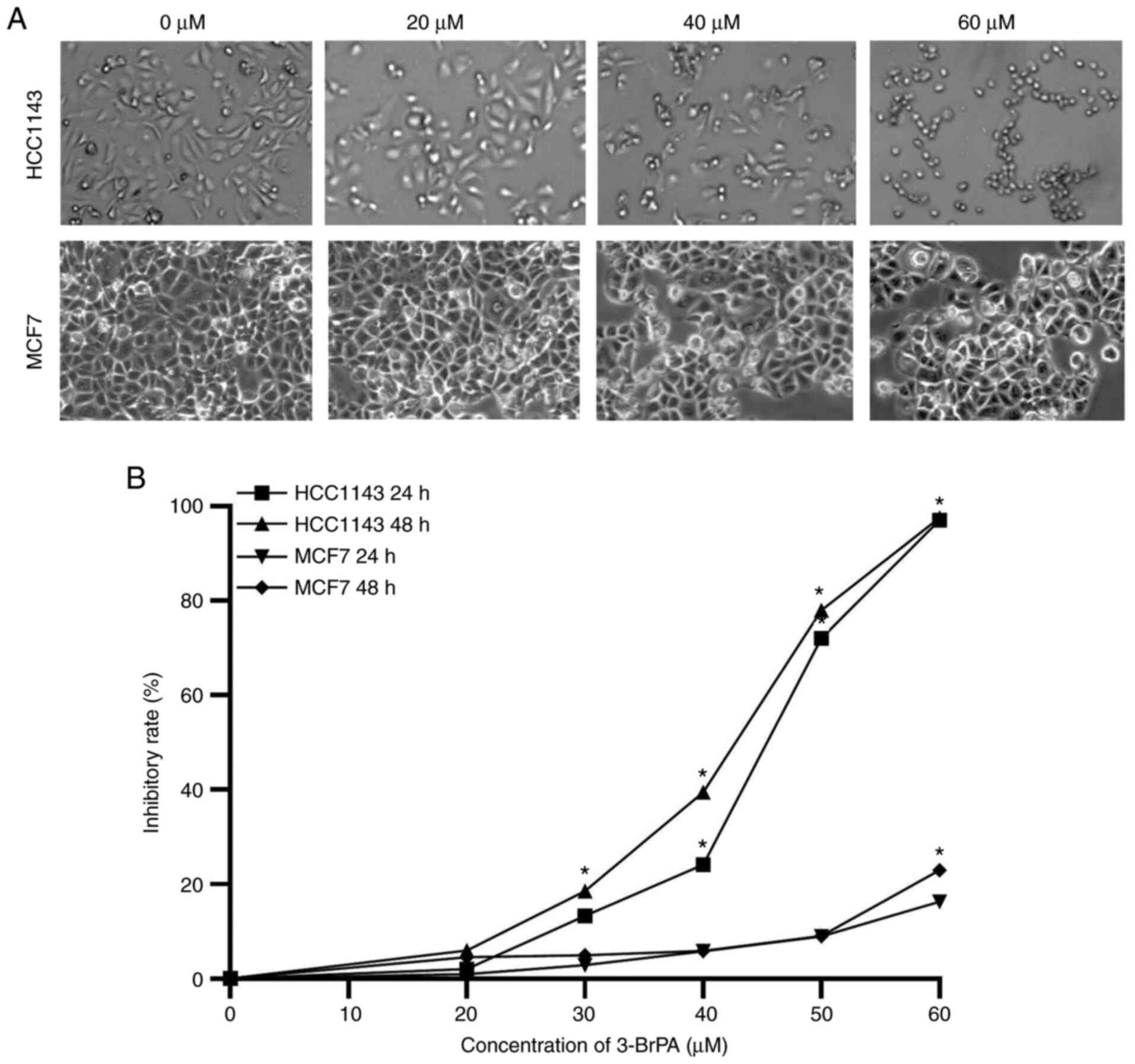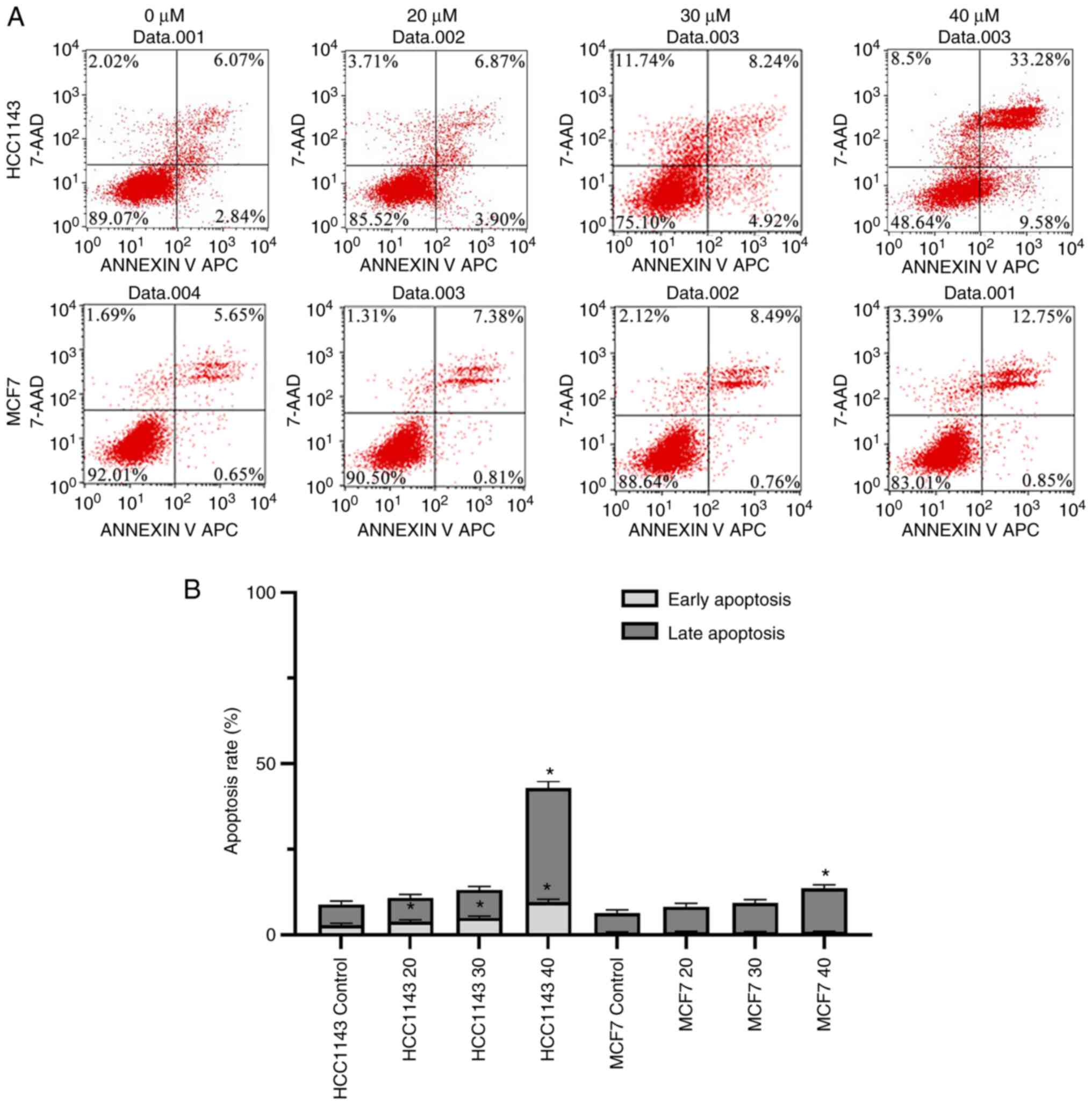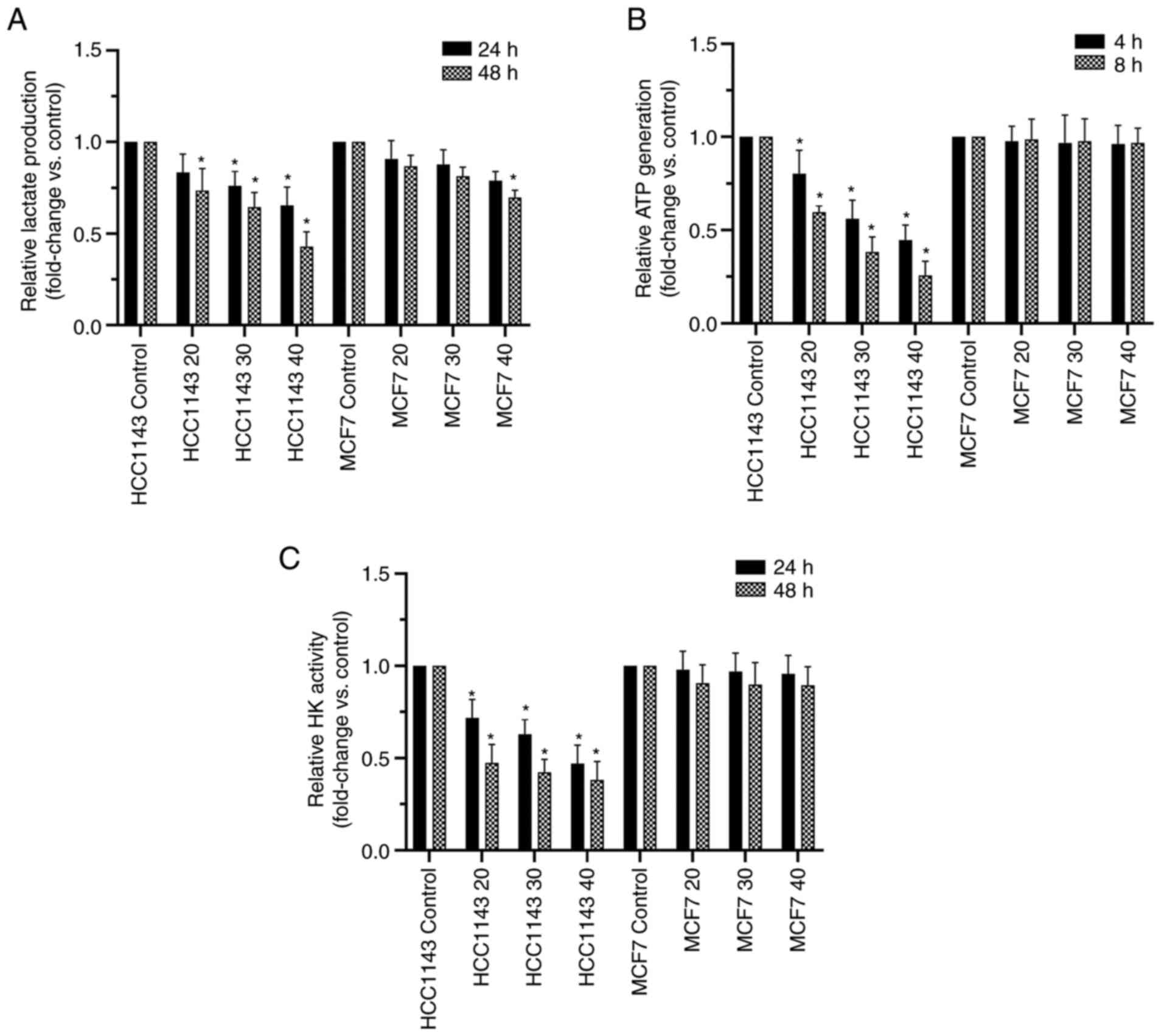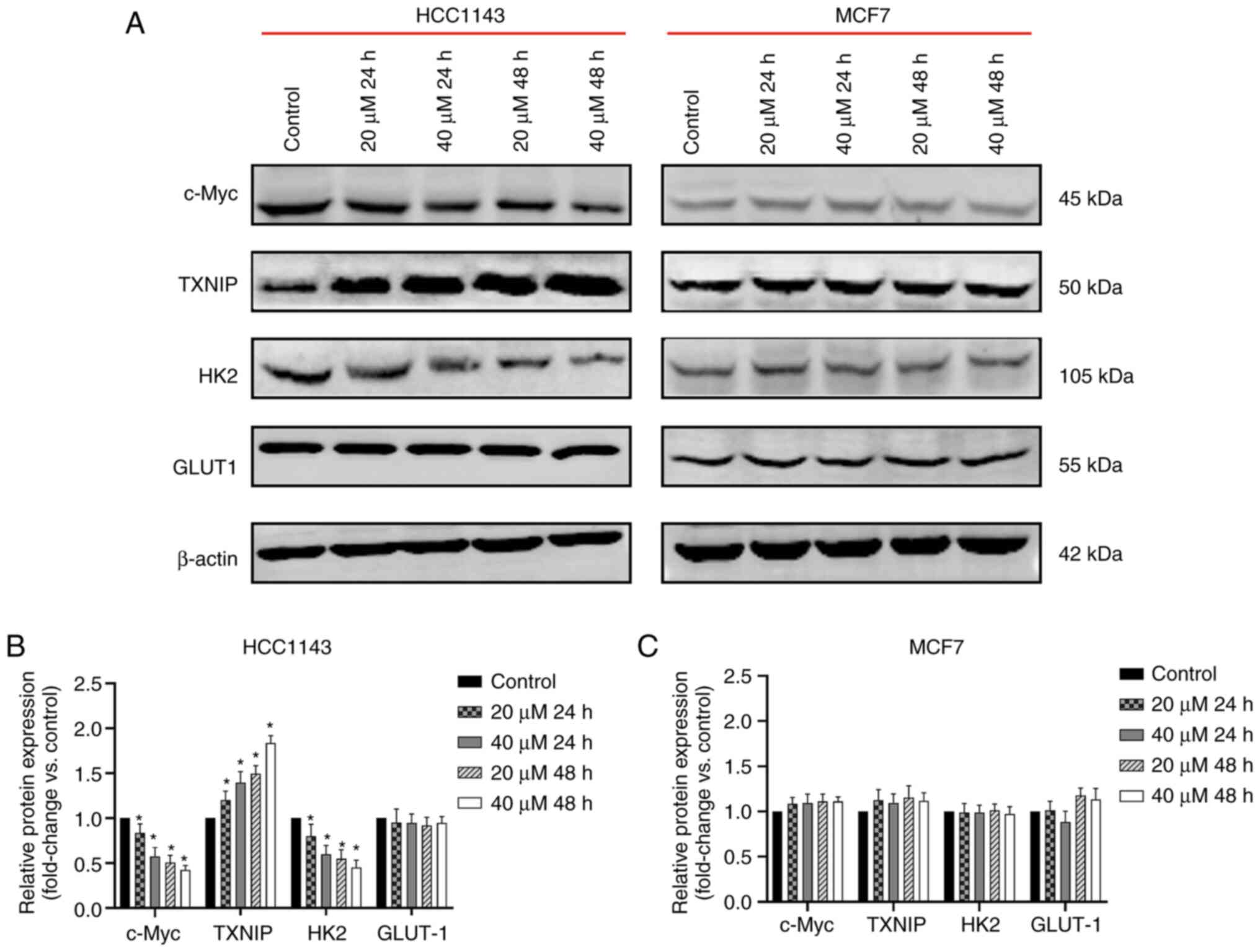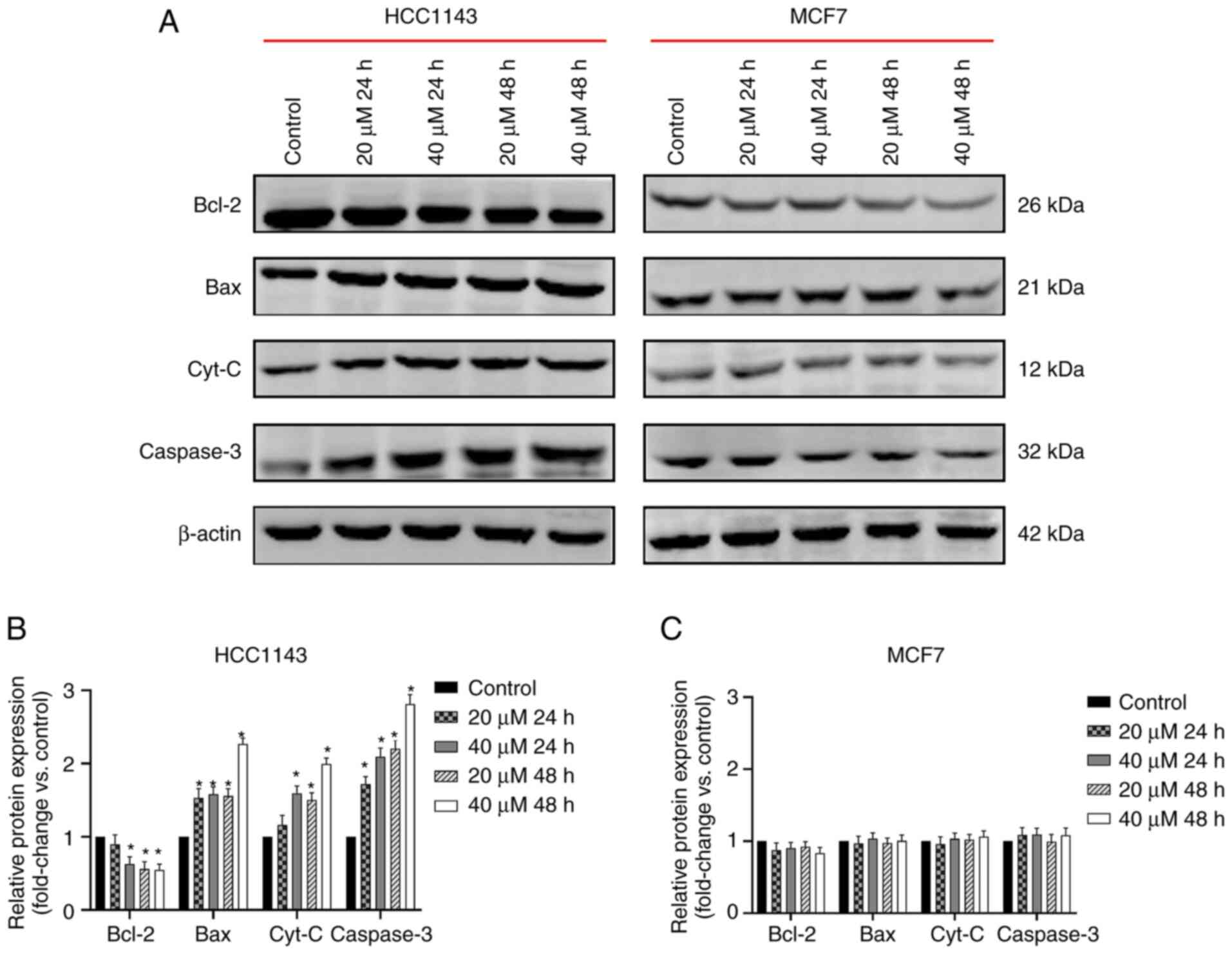|
1
|
Woolston C: Breast cancer. Nature.
527(S101)2015.PubMed/NCBI View
Article : Google Scholar
|
|
2
|
Waks AG and Winer EP: Breast cancer
treatment: A review. JAMA. 321:288–300. 2019.PubMed/NCBI View Article : Google Scholar
|
|
3
|
Foulkes WD, Smith IE and Reis-Filho JS:
Triple-negative breast cancer. N Engl J Med. 363:1938–1948.
2010.PubMed/NCBI View Article : Google Scholar
|
|
4
|
Pelicano H, Zhang W, Liu J, Hammoudi N,
Dai J, Xu RH, Pusztai L and Huang P: Mitochondrial dysfunction in
some triple-negative breast cancer cell lines: Role of mTOR pathway
and therapeutic potential. Breast Cancer Res.
16(434)2014.PubMed/NCBI View Article : Google Scholar
|
|
5
|
Warburg O: On the origin of cancer cells.
Science. 123:309–314. 1956.PubMed/NCBI View Article : Google Scholar
|
|
6
|
Long JP, Li XN and Zhang F: Targeting
metabolism in breast cancer: How far we can go? World J Clin Oncol.
7:122–130. 2016.PubMed/NCBI View Article : Google Scholar
|
|
7
|
Tan VP and Miyamoto S: HK2/hexokinase-II
integrates glycolysis and autophagy to confer cellular protection.
Autophagy. 11:963–964. 2015.PubMed/NCBI View Article : Google Scholar
|
|
8
|
Oronsky BT, Reid T, Knox SJ and Scicinski
JJ: The scarlet letter of alkylation: A mini review of selective
alkylating agents. Transl Oncol. 5:226–229. 2012.PubMed/NCBI View Article : Google Scholar
|
|
9
|
Feng X, Wang P, Liu Q, Zhang T, Mai B and
Wang X: Glycolytic inhibitors 2-deoxyglucose and 3-bromopyruvate
synergize with photodynamic therapy respectively to inhibit cell
migration. J Bioenerg Biomembr. 47:189–197. 2015.PubMed/NCBI View Article : Google Scholar
|
|
10
|
Gan L, Xiu R, Ren P, Yue M, Su H, Guo G,
Xiao D, Yu J, Jiang H, Liu H, et al: Metabolic targeting of
oncogene MYC by selective activation of the proton-coupled
monocarboxylate family of transporters. Oncogene. 35:3037–3048.
2016.PubMed/NCBI View Article : Google Scholar
|
|
11
|
Penny HL, Sieow JL, Adriani G, Yeap WH,
See Chi Ee P, San Luis B, Lee T, Mak SY, Ho YS, Lam KP, et al:
Warburg metabolism in tumor-conditioned macrophages promotes
metastasis in human pancreatic ductal adenocarcinoma.
Oncoimmunology. 5(e1191731)2016.PubMed/NCBI View Article : Google Scholar
|
|
12
|
Thorens B and Mueckler M: Glucose
transporters in the 21st Century. Am J Physiol Endocrinol Metab.
298:E141–E145. 2010.PubMed/NCBI View Article : Google Scholar
|
|
13
|
Choi J, Jung WH and Koo JS:
Metabolism-related proteins are differentially expressed according
to the molecular subtype of invasive breast cancer defined by
surrogate immunohistochemistry. Pathobiology. 80:41–52.
2013.PubMed/NCBI View Article : Google Scholar
|
|
14
|
Yadav S, Pandey SK, Kumar A, Kujur PK,
Singh RP and Singh SM: Antitumor and chemosensitizing action of
3-bromopyruvate: Implication of deregulated metabolism. Chem Biol
Interact. 270:73–89. 2017.PubMed/NCBI View Article : Google Scholar
|
|
15
|
Wu N, Zheng B, Shaywitz A, Dagon Y, Tower
C, Bellinger G, Shen CH, Wen J, Asara J, McGraw TE, et al:
AMPK-dependent degradation of TXNIP upon energy stress leads to
enhanced glucose uptake via GLUT1. Mol Cell. 49:1167–1175.
2013.PubMed/NCBI View Article : Google Scholar
|
|
16
|
Alhawiti NM, Al Mahri S, Aziz MA, Malik SS
and Mohammad S: TXNIP in metabolic regulation: Physiological role
and therapeutic outlook. Curr Drug Targets. 18:1095–1103.
2017.PubMed/NCBI View Article : Google Scholar
|
|
17
|
O'Shea JM and Ayer DE: Coordination of
nutrient availability and utilization by MAX- and MLX-centered
transcription networks. Cold Spring Harb Perspect Med.
3(a014258)2013.PubMed/NCBI View Article : Google Scholar
|
|
18
|
Zhou J, Yu Q and Chng WJ: TXNIP (VDUP-1,
TBP-2): A major redox regulator commonly suppressed in cancer by
epigenetic mechanisms. Int J Biochem Cell Biol. 43:1668–1673.
2011.PubMed/NCBI View Article : Google Scholar
|
|
19
|
Cadenas C, Franckenstein D, Schmidt M,
Gehrmann M, Hermes M, Geppert B, Schormann W, Maccoux LJ, Schug M,
Schumann A, et al: Role of thioredoxin reductase 1 and thioredoxin
interacting protein in prognosis of breast cancer. Breast Cancer
Res. 12(R44)2010.PubMed/NCBI View Article : Google Scholar
|
|
20
|
Chen JL, Merl D, Peterson CW, Wu J, Liu
PY, Yin H, Muoio DM, Ayer DE, West M and Chi JT: Lactic acidosis
triggers starvation response with paradoxical induction of TXNIP
through MondoA. PLoS Genet. 6(e1001093)2010.PubMed/NCBI View Article : Google Scholar
|
|
21
|
Shen L, O'Shea JM, Kaadige MR, Cunha S,
Wilde BR, Cohen AL, Welm AL and Ayer DE: Metabolic reprogramming in
triple-negative breast cancer through Myc suppression of TXNIP.
Proc Natl Acad Sci USA. 112:5425–5430. 2015.PubMed/NCBI View Article : Google Scholar
|
|
22
|
Iqbal MA, Chattopadhyay S, Siddiqui FA, Ur
Rehman A, Siddiqui S, Prakasam G, Khan A, Sultana S and Bamezai RN:
Silibinin induces metabolic crisis in triple-negative breast cancer
cells by modulating EGFR-MYC-TXNIP axis: Potential therapeutic
implications. FEBS J. 288:471–485. 2021.PubMed/NCBI View Article : Google Scholar
|
|
23
|
Rabinowitz JD and Enerbäck S: Lactate: The
ugly duckling of energy metabolism. Nat Metab. 2:566–571.
2020.PubMed/NCBI View Article : Google Scholar
|
|
24
|
Ganapathy-Kanniappan S and Geschwind JF:
Tumor glycolysis as a target for cancer therapy: Progress and
prospects. Mol Cancer. 12(152)2013.PubMed/NCBI View Article : Google Scholar
|
|
25
|
Jiang M, Liu S, Lin J, Hao W, Wei B, Gao
Y, Kong C, Yu M and Zhu Y: A pan-cancer analysis of molecular
characteristics and oncogenic role of hexokinase family genes in
human tumors. Life Sci. 264(118669)2021.PubMed/NCBI View Article : Google Scholar
|
|
26
|
Howlader N, Cronin KA, Kurian AW and
Andridge R: Differences in breast cancer survival by molecular
subtypes in the United States. Cancer Epidemiol Biomarkers Prev.
27:619–626. 2018.PubMed/NCBI View Article : Google Scholar
|
|
27
|
Lehmann BD, Bauer JA, Chen X, Sanders ME,
Chakravarthy AB, Shyr Y and Pietenpol JA: Identification of human
triple-negative breast cancer subtypes and preclinical models for
selection of targeted therapies. J Clin Invest. 121:2750–2767.
2011.PubMed/NCBI View Article : Google Scholar
|
|
28
|
Jiao L, Zhang HL, Li DD, Yang KL, Tang J,
Li X, Ji J, Yu Y, Wu RY, Ravichandran S, et al: Regulation of
glycolytic metabolism by autophagy in liver cancer involves
selective autophagic degradation of HK2 (hexokinase 2). Autophagy.
14:671–684. 2018.PubMed/NCBI View Article : Google Scholar
|
|
29
|
Fan T, Sun G, Sun X, Zhao L, Zhong R and
Peng Y: Tumor energy metabolism and Potential of 3-bromopyruvate as
an inhibitor of aerobic glycolysis: Implications in tumor
treatment. Cancers (Basel). 11(317)2019.PubMed/NCBI View Article : Google Scholar
|
|
30
|
Nikravesh H, Khodayar MJ, Behmanesh B,
Mahdavinia M, Teimoori A, Alboghobeish S and Zeidooni L: The
combined effect of dichloroacetate and 3-bromopyruvate on glucose
metabolism in colorectal cancer cell line, HT-29; the mitochondrial
pathway apoptosis. BMC Cancer. 21(903)2021.PubMed/NCBI View Article : Google Scholar
|
|
31
|
Niedźwiecka K, Dyląg M, Augustyniak D,
Majkowska-Skrobek G, Cal-Bąkowska M, Ko YH, Pedersen PL, Goffeau A
and Ułaszewski S: Glutathione may have implications in the design
of 3-bromopyruvate treatment protocols for both fungal and algal
infections as well as multiple myeloma. Oncotarget. 7:65614–65626.
2016.PubMed/NCBI View Article : Google Scholar
|
|
32
|
Ko YH, Verhoeven HA, Lee MJ, Corbin DJ,
Vogl TJ and Pedersen PL: A translational study ‘case report’ on the
small molecule ‘energy blocker’ 3-bromopyruvate (3BP) as a potent
anticancer agent: From bench side to bedside. J Bioenerg Biomembr.
44:163–170. 2012.PubMed/NCBI View Article : Google Scholar
|
|
33
|
Lis P, Dyląg M, Niedźwiecka K, Ko YH,
Pedersen PL, Goffeau A and Ułaszewski S: The HK2 dependent ‘Warburg
Effect’ and mitochondrial oxidative phosphorylation in cancer:
Targets for effective therapy with 3-bromopyruvate. Molecules.
21(1730)2016.PubMed/NCBI View Article : Google Scholar
|
|
34
|
Wilson JE: Isozymes of mammalian
hexokinase: Structure, subcellular localization and metabolic
function. J Exp Biol. 206 (Pt 12):2049–2057. 2003.PubMed/NCBI View Article : Google Scholar
|
|
35
|
Patra KC and Hay N: Hexokinase 2 as
oncotarget. Oncotarget. 4:1862–1863. 2013.PubMed/NCBI View Article : Google Scholar
|
|
36
|
Patra KC, Wang Q, Bhaskar PT, Miller L,
Wang Z, Wheaton W, Chandel N, Laakso M, Muller WJ, Allen EL, et al:
Hexokinase 2 is required for tumor initiation and maintenance and
its systemic deletion is therapeutic in mouse models of cancer.
Cancer Cell. 24:213–228. 2013.PubMed/NCBI View Article : Google Scholar
|
|
37
|
Marini C, Salani B, Massollo M, Amaro A,
Esposito AI, Orengo AM, Capitanio S, Emionite L, Riondato M,
Bottoni G, et al: Direct inhibition of hexokinase activity by
metformin at least partially impairs glucose metabolism and tumor
growth in experimental breast cancer. Cell Cycle. 12:3490–3499.
2013.PubMed/NCBI View Article : Google Scholar
|
|
38
|
Park JW, Lee SH, Woo GH, Kwon HJ and Kim
DY: Downregulation of TXNIP leads to high proliferative activity
and estrogen-dependent cell growth in breast cancer. Biochem
Biophys Res Commun. 498:566–572. 2018.PubMed/NCBI View Article : Google Scholar
|
|
39
|
Qu X, Sun J, Zhang Y, Li J, Hu J, Li K,
Gao L and Shen L: c-Myc-driven glycolysis via TXNIP suppression is
dependent on glutaminase-MondoA axis in prostate cancer. Biochem
Biophys Res Commun. 504:415–421. 2018.PubMed/NCBI View Article : Google Scholar
|
|
40
|
Chen H, Liu H and Qing G: Targeting
oncogenic Myc as a strategy for cancer treatment. Signal Transduct
Target Ther. 3(5)2018.PubMed/NCBI View Article : Google Scholar
|
|
41
|
Stasevich EM, Murashko MM, Zinevich LS,
Demin DE and Schwartz AM: The Role of Non-Coding RNAs in the
regulation of the proto-oncogene MYC in different types of cancer.
Biomedicines. 9(921)2021.PubMed/NCBI View Article : Google Scholar
|
|
42
|
Chauhan A, Paul R, Debnath M, Bessi I,
Mandal S, Schwalbe H and Dash J: Synthesis of fluorescent
binaphthyl amines that Bind c-MYC G-Quadruplex DNA and Repress
c-MYC expression. J Med Chem. 59:7275–7281. 2016.PubMed/NCBI View Article : Google Scholar
|
|
43
|
Gao Y, Miles SL, Dasgupta P, Rankin GO,
Cutler S and Chen YC: Trichodermin Induces G0/G1 cell cycle arrest
by inhibiting c-Myc in ovarian cancer cells and tumor
xenograft-bearing mice. Int J Mol Sci. 22(5022)2021.PubMed/NCBI View Article : Google Scholar
|
|
44
|
McMahon SB: MYC and the control of
apoptosis. Cold Spring Harb Perspect Med. 4(a014407)2014.PubMed/NCBI View Article : Google Scholar
|
|
45
|
Sun L, Song L, Wan Q, Wu G, Li X, Wang Y,
Wang J, Liu Z, Zhong X, He X, et al: cMyc-mediated activation of
serine biosynthesis pathway is critical for cancer progression
under nutrient deprivation conditions. Cell Res. 25:429–444.
2015.PubMed/NCBI View Article : Google Scholar
|
|
46
|
Liu Y, Xiang F, Huang Y, Shi L, Hu C, Yang
Y, Wang D, He N, Tao K, Wu K and Wang G: Interleukin-22 promotes
aerobic glycolysis associated with tumor progression via targeting
hexokinase-2 in human colon cancer cells. Oncotarget.
8:25372–25383. 2017.PubMed/NCBI View Article : Google Scholar
|
|
47
|
Yu P, Li AX, Chen XS, Tian M, Wang HY,
Wang XL, Zhang Y, Wang KS and Cheng Y: PKM2-c-Myc-survivin cascade
regulates the cell proliferation, migration, and tamoxifen
resistance in breast cancer. Front Pharmacol.
11(550469)2020.PubMed/NCBI View Article : Google Scholar
|
|
48
|
Yang W, Zheng Y, Xia Y, Ji H, Chen X, Guo
F, Lyssiotis CA, Aldape K, Cantley LC and Lu Z: ERK1/2-dependent
phosphorylation and nuclear translocation of PKM2 promotes the
Warburg effect. Nat Cell Biol. 14:1295–1304. 2012.PubMed/NCBI View Article : Google Scholar
|
|
49
|
Feng J, Li J, Wu L, Yu Q, Ji J, Wu J, Dai
W and Guo C: Emerging roles and the regulation of aerobic
glycolysis in hepatocellular carcinoma. J Exp Clin Cancer Res.
39(126)2020.PubMed/NCBI View Article : Google Scholar
|
|
50
|
Dhanasekaran R, Deutzmann A,
Mahauad-Fernandez WD, Hansen AS, Gouw AM and Felsher DW: The MYC
oncogene - the grand orchestrator of cancer growth and immune
evasion. Nat Rev Clin Oncol. 19:23–36. 2022.PubMed/NCBI View Article : Google Scholar
|
|
51
|
Skaripa-Koukelli I, Hauton D,
Walsby-Tickle J, Thomas E, Owen J, Lakshminarayanan A, Able S,
McCullagh J, Carlisle RC and Vallis KA: 3-Bromopyruvate-mediated
MCT1-dependent metabolic perturbation sensitizes triple negative
breast cancer cells to ionizing radiation. Cancer Metab.
9(37)2021.PubMed/NCBI View Article : Google Scholar
|
|
52
|
Pereira-Vieira J, Azevedo-Silva J, Preto
A, Casal M and Queirós O: MCT1, MCT4 and CD147 expression and
3-bromopyruvate toxicity in colorectal cancer cells are modulated
by the extracellular conditions. Biol Chem. 400:787–799.
2019.PubMed/NCBI View Article : Google Scholar
|
|
53
|
Shen S, Yao T, Xu Y, Zhang D, Fan S and Ma
J: CircECE1 activates energy metabolism in osteosarcoma by
stabilizing c-Myc. Mol Cancer. 19(151)2020.PubMed/NCBI View Article : Google Scholar
|
|
54
|
Meyer N and Penn LZ: Reflecting on 25
years with MYC. Nat Rev Cancer. 8:976–990. 2008.PubMed/NCBI View Article : Google Scholar
|
|
55
|
Kaadige MR, Yang J, Wilde BR and Ayer DE:
MondoA-Mlx transcriptional activity is limited by mTOR-MondoA
interaction. Mol Cell Biol. 35:101–110. 2015.PubMed/NCBI View Article : Google Scholar
|
|
56
|
Peterson CW, Stoltzman CA, Sighinolfi MP,
Han KS and Ayer DE: Glucose controls nuclear accumulation, promoter
binding, and transcriptional activity of the MondoA-Mlx
heterodimer. Mol Cell Biol. 30:2887–2895. 2010.PubMed/NCBI View Article : Google Scholar
|
|
57
|
Zhang B, Lyu J, Liu Y, Wu C, Yang EJ,
Pardeshi L, Tan K, Wong KH, Chen Q, Xu X, et al: BRCA1 deficiency
sensitizes breast cancer cells to bromodomain and extra-terminal
domain (BET) inhibition. Oncogene. 37:6341–6356. 2018.PubMed/NCBI View Article : Google Scholar
|
|
58
|
Gao YH, Zhang HP, Yang SM, Yang Y, Ma YY,
Zhang XY and Yang YM: Inactivation of Akt by arsenic trioxide
induces cell death via mitochondrial-mediated apoptotic signaling
in SGC-7901 human gastric cancer cells. Oncol Rep. 31:1645–1652.
2014.PubMed/NCBI View Article : Google Scholar
|
|
59
|
Brunelle JK and Letai A: Control of
mitochondrial apoptosis by the Bcl-2 family. J Cell Sci.
122:437–441. 2009.PubMed/NCBI View Article : Google Scholar
|
|
60
|
Pistritto G, Trisciuoglio D, Ceci C,
Garufi A and D'Orazi G: Apoptosis as anticancer mechanism: Function
and dysfunction of its modulators and targeted therapeutic
strategies. Aging.(Albany NY). 8:603–619. 2016.PubMed/NCBI View Article : Google Scholar
|
|
61
|
Yu C, Du F, Zhang C, Li Y, Liao C, He L,
Cheng X and Zhang X: Salmonella enterica serovar Typhimurium sseK3
induces apoptosis and enhances glycolysis in macrophages. BMC
Microbiol. 20(151)2020.PubMed/NCBI View Article : Google Scholar
|
|
62
|
Krasnov GS, Dmitriev AA, Lakunina VA,
Kirpiy AA and Kudryavtseva AV: Targeting VDAC-bound hexokinase II:
A promising approach for concomitant anti-cancer therapy. Expert
Opin Ther Targets. 17:1221–1233. 2013.PubMed/NCBI View Article : Google Scholar
|
|
63
|
Kwiatkowska E, Wojtala M, Gajewska A,
Soszyński M, Bartosz G and Sadowska-Bartosz I: Effect of
3-bromopyruvate acid on the redox equilibrium in non-invasive MCF-7
and invasive MDA-MB-231 breast cancer cells. J Bioenerg Biomembr.
48:23–32. 2016.PubMed/NCBI View Article : Google Scholar
|
|
64
|
Wu L, Xu J, Yuan W, Wu B, Wang H, Liu G,
Wang X, Du J and Cai S: The reversal effects of 3-bromopyruvate on
multidrug resistance in vitro and in vivo derived from human breast
MCF-7/ADR cells. PLoS One. 9(e112132)2014.PubMed/NCBI View Article : Google Scholar
|
|
65
|
Akins NS, Nielson TC and Le HV: Inhibition
of glycolysis and glutaminolysis: An emerging drug discovery
approach to combat cancer. Curr Top Med Chem. 18:494–504.
2018.PubMed/NCBI View Article : Google Scholar
|















